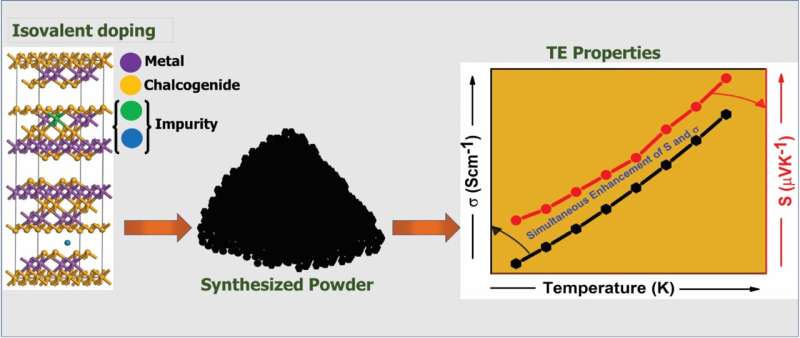Advances in thermoelectric power generation possible with various 'metal chalcogenide' materials

Scientists on the forefront of the rapidly growing field of thermoelectric power generation have found that metals and metalloid compounds built upon antimony, lead, copper, tin, and bismuth hold the potential to aid in developing more efficient energy recapture materials and devices—a critical area of need as the global scientific community seeks ways of reducing greenhouse gas emissions.
A research team led by Professor Lawrence Wu in the Department of Materials Science and Engineering at City University of Hong published a review examining recent studies that have sought to discover more efficient and effective thermoelectric materials.
The review was published on October 21 in Nano Research Energy.
The studies included in the research team's review focused specifically on studies that conducted experiments with substituting different metal compounds called chalcogenides, which are common across the renewable energy sector and found in applications such as photovoltaic cells, batteries, sensors, and fuel cells, to name a few. Such compounds have in common that they all tend to function as a catalyst among two or more forms of energy.
Though thermoelectric materials have been known to exist since the late 1800s, the idea of harnessing their ability to recapture heat energy as electrical current wasn't more intensely studied until the mid-20th century, when the scientific community began to explore space and needed ways of powering satellites and other space vehicles for long periods.
The review notes that about 90 percent of energy consumed by human activities is generated by thermal processes and eventually dissipates as heat, illustrating the vast opportunity inherent to developing better ways of capturing waste heat at factories, power plants, from vehicles, and even building exteriors in hot climates.
"Energy generation is likely to be the foremost scientific challenge in years to come. The adverse effect of fossil fuels on the environment is driving research to explore alternative energy sources," Wu said. "Studies have demonstrated that renewables can offer a promising strategy to curb the problem, among which thermoelectric technology stands tall."
Wu and his team examined studies on a technique within thermoelectric material development called isovalent substitution, which refers to the mechanism of substituting a host atom with an impurity atom when the impurity atom possesses the same valence number as the host atom.
"This technique has opened up a new approach that leads to higher charge density and electron mobility across these novel materials," Wu said. "The goal is to recapture as much energy as possible in the form of an electric charge, and these thermoelectric materials—particularly one we examined based on the elements bismuth and cerium—fit that bill."
Other metal chalcogenides built on lead, gallium, copper, germanium, and tin demonstrated performance characteristics that rivaled each other, depending on temperature, pressure, and type of isovalent substitution. Bismuth-tellurium and a bismuth-antimony-tellurium compound stood out as the top thermoelectric material the team found among the studies reviewed.
"In conclusion, the system of isovalent substitution is an effective technique of doping to enhance the thermoelectric material performance," Wu said.
"What this tells us is that there is still a vast about of untapped potential for developing materials that will increase the efficiency and range of electric vehicles, help governments and industry cut down on fossil fuel use, and even pave the way for sustaining future human colonies on the moon and on Mars, where energy production and storage alternatives to solar will be necessary. We plan to continue monitoring new developments in the field of thermoelectric generation."
More information: Jamal-Deen Musah et al, Isovalent substitution in metal chalcogenide materials for improving thermoelectric power generation—A critical review, Nano Research Energy (2022). DOI: 10.26599/NRE.2022.9120034

















